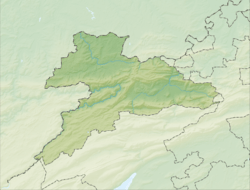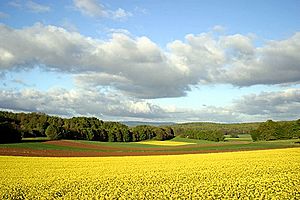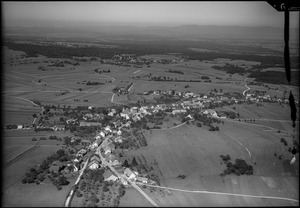Bure, Switzerland facts for kids
Quick facts for kids
Bure
|
||
|---|---|---|

Bure village church
|
||
|
||
| Country | Switzerland | |
| Canton | Jura | |
| District | Porrentruy | |
| Area | ||
| • Total | 13.68 km2 (5.28 sq mi) | |
| Elevation | 587 m (1,926 ft) | |
| Population
(Dec 2020 )
|
||
| • Total | 645 | |
| • Density | 47.15/km2 (122.12/sq mi) | |
| Postal code |
2915
|
|
| Surrounded by | Buix, Courtemaîche, Courchavon, Porrentruy, Courtedoux, Chevenez, Fahy, Croix (F), Villars-le-Sec (F) | |
Bure is a small town, also called a municipality, located in the Jura canton of Switzerland. It's part of the Porrentruy district and is very close to the border with France.
Contents
Bure's Past: A Quick Look at History
Bure was first written about in the year 1139. Back then, it was called Bures. For a while, it also had a German name, Burnen, but people don't use that name anymore.
Where is Bure? Geography and Land Use
Bure covers an area of about 13.69 square kilometers (around 5.29 square miles). A big part of this land, about 44.5%, is used for farming. This means there are lots of fields for crops and pastures for animals.
About 27.9% of Bure is covered by forests. These are important natural areas. Around 13.3% of the land has buildings or roads on it. The rest, about 14.4%, is land that can't be used for farming or building, like rocky areas.
Bure is right on the border with France, which makes it a special location.
Bure's Coat of Arms
Every town has a special symbol called a coat of arms. Bure's coat of arms is red and shows a silver pig jumping up. This design is called Gules, a Pig salient Argent.
Who Lives in Bure? Population Facts
Bure has a population of about 687 people (as of 2003). A small number of people living here, about 3.7%, are from other countries. Over the past 10 years, the number of people in Bure has changed a little.
Most people in Bure, about 98%, speak French as their main language. A few people speak German (1.9%), and even fewer speak Italian (0.1%).
In 2008, there were slightly more men (51.2%) than women (48.8%) living in Bure. Many residents were born in Bure or elsewhere in the same canton.
Age Groups in Bure
In 2000, about 26.6% of the people in Bure were children and teenagers (under 20 years old). Adults (20-64 years old) made up the largest group at 60.1%. Older adults (over 64 years old) made up 13.3% of the population.
Homes in Bure
In 2000, there were 266 homes in Bure, with about 2.5 people living in each home on average. Most homes were lived in all the time.
The chart below shows how Bure's population has changed over many years:

How People Work in Bure: The Economy
In 2010, about 5.1% of people in Bure who wanted to work didn't have a job. Many people in Bure work in different areas.
Types of Jobs
- Farming: About 30 people work in farming, like growing crops or raising animals. There are 11 farming businesses.
- Making Things: Around 31 people work in factories or construction. There are 9 businesses in this area.
- Services: The biggest group, 115 people, work in service jobs. This includes things like shops, restaurants, healthcare, and education. There are 15 service businesses.
Many people who live in Bure travel to other towns for work. About 72.7% of working people use a private car to get to their jobs.
Religion in Bure
Based on a 2000 survey, most people in Bure, about 88.6%, are Roman Catholic. About 5.8% belong to the Swiss Reformed Church. A small number of people belong to other churches or do not follow any religion.
Learning in Bure: Education
In Bure, about 30.8% of people have finished high school. About 7.3% have gone on to higher education, like university.
School System in Jura
The Jura canton has a specific school system:
- Kindergarten: Two years of optional kindergarten.
- Primary School: Six years of primary school, which is required.
- Lower Secondary School: Three years of required secondary school. Students are grouped by their skills.
- Upper Secondary School: After secondary school, students can choose to go to an optional three or four-year upper secondary school, or start an apprenticeship to learn a trade.
In the 2009-2010 school year, Bure had one kindergarten class with 17 students. Bure doesn't have its own primary or secondary schools. Students from Bure go to schools in nearby towns.
See also
 In Spanish: Bure (Jura) para niños
In Spanish: Bure (Jura) para niños






